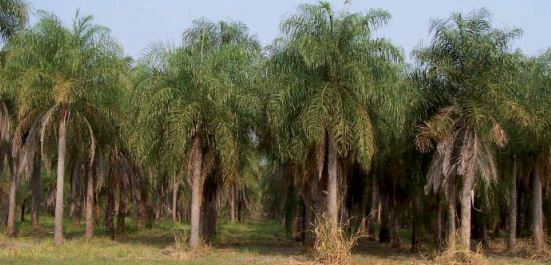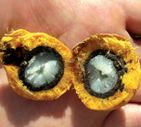Knowledge fuels change
For over a decade, Energypedia has shared free, reliable energy expertise with the world.
We’re now facing a serious funding gap.
Help keep this platform alive — your donation, big or small, truly matters!
Thank you for your support
Acrocomia Aculeata – Oil Crop
Overview
| The South-American palm species Acrocomia aculeata has great potential as a sustainable source for vegetable oils and provides economic opportunities for both smallholders and investors on less fertile crop- and grassland in sub-/tropical regions with limited rainfall. Past years’ research has made the plant ready for commercialisation. Now, pilot projects are needed to demonstrate its viability. Secure supply of sustainably produced agricultural products is a major challenge of the 21st century, in particular with regard to vegetable oils. |
Old Crop with New Potential
|
|
Acrocomia aculeata is a thorny palm species native to South America and distributed in the tropics and subtropics from Mexico to Argentina. It reachesa height between eight and twelve metres. Few relevant pests or pathogens are known. In contrast to Elaeis guineensis the genus Acrocomia shows high plasticity with regard to environmental conditions. Acrocomia species occur in temperate and tropical regions and thrive under annual precipitation from 1,000 to 2,500 millimetres[1]. For a short time, even freezing (–5 °C) is tolerated. Acrocomia palms can tolerate fire and prolonged drought up to six months[1]. Excluding water logging, Acrocomia grows on a diversity of soils[2], where high amounts of sand and organic matter are preferred[3], and it has been also cultivated on nutrient-poor sandy soils[4]. The plant has manifold traditional uses for food specialties, animal feed, fibre or medicine. But its main products, oils from fruit pulp and kernel, may boost its importance as an economically viable alternative to Elaeis guineensis that does not compete with rainforest or fertile land. |
Sustainable Oil Crop
In addition to its low costs, the oil palm Elaeis guineensis is favoured for its high contents of lauric acid in kernel oil used in foods and cosmetics and its low contents of polyunsaturated fatty acids in palm oil (= pulp oil), respectively. The Table above compares relevant fatty acid (FA) contents of pulp and kernel oils of both Acrocomia and Elaeis. By evidence, Acrocomia oils already meet a similar composition, and including genetic variation and improvement, Acrocomia is fully suitable to substitute Elaeis oils by quality. However, because the site requirements of Acrocomia differ from those of the African oil palm, Acrocomia has the
potential for a sustainable expansion of plant oil production area. In addition, storage stability of Acrocomia fruits is much higher than that of Elaeis fruits. This allows for decentralised production and storage. Its proven processing technology is comparably simple and already cost-efficient at a scale of 5,000 metric tons (MT) of fruits per year. This corresponds to a plantation area of about 250 hectares (ha), as an average yield of 20 MT of fruits per hectare and year can be expected from the fifth year after planting. The Figure below illustrates the processing steps and typical fractionation of Acrocomia fruits, important uses of the products and the resulting revenues for each fraction. Market values are based on experiences in Paraguay and comparable commodities.
Economic Chances
With a total annual yield of more than 2.5 metric tons (MT) of oil per hectare and a range of valuable by-products Acrocomia is also economically interesting. For all products derived from the Acrocomia oil palm there are existing local or international markets. Most of these markets promise future growth and Acrocomia’s product diversity entails risk diversification. These are important characteristics for investors. But its small-scale viability also makes Acrocomia a promising opportunity for smallholders. In many tropical and subtropical regions large areas are cultiated with few crops in capital-intensive monocultures with disputable ecological and long-term economic sustainability. Product diversity is not established in industrial production as a rule. In contrast, smallholders frequently cultivate native plants that are rarely grown in large scales due to lack of domestication or standardisation. Acrocomia can even be grown in mixed cultures and processed in small quantities. This allows for its production in small-structured, perennial and capitalextensive cropping systems that improve participation of small farms in rural development. In addition, Acrocomia is a profitable crop for the less fertile soils of a farm and can thus contribute to improving land use efficiency. If established on degraded land, the plant may also serve as a carbon sink and enrich the soil with organic matter during its long productive lifetime of 60 to 70 years. In summary, Acrocomia can help diversify income sources of smallholders as well as the portfolio of global plant oil production. There is only one disadvantage: a temporal gap between investment and profits. It takes five or six years until first harvest, and even small processing facilities need capital. While the years without harvest can be bridged by alley cropping, e.g. with camelina, groundnut, castor or cassava, a commitment of investors or financial tools for cooperatives are desirable for the establishment of Acrocomia factories.
Further Information
- More about the experiences from Paraguay and what is needed to reliese the potential of this crop please read the full paper (Rural 21 – 03/2012)
- Acrocomia Solutions S.R.L.
- Vegetable Oil, Current Plant Oil Market
- Jatropha
References
- From the Document Rural 21 – 03/2012, Original Authors:
- Jens Poetsch,PlanetRenew GmbH,Tübingen, Germany
- Daniela Haupenthal, Universidad Católica del Paraguay,Campus Itapúa, Hohenau, Paraguay
- Iris Lewandowski, Dieter Oberländer and Thomas Hilger, University of Hohenheim,Stuttgart, Germany





















